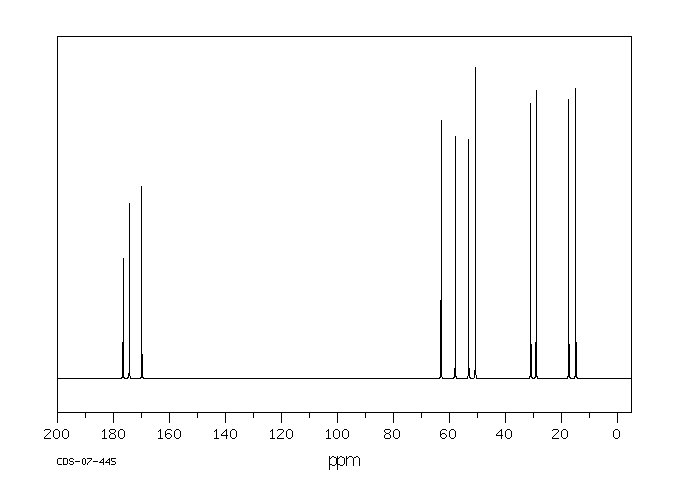Met-Ala-Ser
中文名称
——
中文别名
——
英文名称
Met-Ala-Ser
英文别名
MAS;(2S)-2-[[(2S)-2-[[(2S)-2-azaniumyl-4-methylsulfanylbutanoyl]amino]propanoyl]amino]-3-hydroxypropanoate
CAS
——
化学式
C11H21N3O5S
mdl
——
分子量
307.371
InChiKey
WXHHTBVYQOSYSL-FXQIFTODSA-N
BEILSTEIN
——
EINECS
——
-
物化性质
-
计算性质
-
ADMET
-
安全信息
-
SDS
-
制备方法与用途
-
上下游信息
-
文献信息
-
表征谱图
-
同类化合物
-
相关功能分类
-
相关结构分类
计算性质
-
辛醇/水分配系数(LogP):-4.4
-
重原子数:20
-
可旋转键数:9
-
环数:0.0
-
sp3杂化的碳原子比例:0.73
-
拓扑面积:167
-
氢给体数:5
-
氢受体数:7
上下游信息
-
上游原料
中文名称 英文名称 CAS号 化学式 分子量 —— N-formylmethionine-alanine-serine —— C12H21N3O6S 335.381
反应信息
-
作为反应物:描述:、 Met-Ala-Ser 在 盐酸 、 sodium hydroxide 、 potassium hexacyanoferrate(III) 作用下, 以 水 、 重水 为溶剂, 反应 0.33h, 以75%的产率得到C19H32N6O9S参考文献:名称:水中化学选择性氨基腈偶联的肽连接摘要:酰胺键的形成是化学和生物学中最重要的反应之一 1-4,但目前还没有化学方法可以在水中实现 α-肽连接,从而耐受肽连接位点的所有 20 种蛋白质氨基酸。通用遗传密码确立了肽的生物学作用早于生命最后一个普遍的共同祖先,并且肽在生命起源中发挥了重要作用5-9。硫在柠檬酸循环、非核糖体肽合成和聚酮化合物生物合成中的重要作用指向在生命进化过程中,硫酯依赖性肽连接先于 RNA 依赖性蛋白质合成 5,9-13。然而,尚未证明氨酰基硫酯形成的稳健机制。在这里,我们报告了一种化学选择性,高产 α-氨基腈连接,仅利用益生元合理的分子——硫化氢、硫代乙酸盐 12,14 和铁氰化物 12,14-17 或氰基乙炔 8,14——在水中产生 α-肽。这种连接对 α-氨基腈偶联具有极高的选择性,并能耐受所有 20 个蛋白质氨基酸残基。两个基本特征使肽能够在水中连接:α-氨基腈的反应性和 pKaH 使它们与中性 pH 值的DOI:10.1038/s41586-019-1371-4
-
作为产物:描述:N-formylmethionine-alanine-serine 在 Staphylococcus aureus peptide deformylase 、 β-烟酰胺腺嘌呤二核苷酸 作用下, 以 various solvent(s) 为溶剂, 生成 Met-Ala-Ser参考文献:名称:Macrolactin N, a new peptide deformylase inhibitor produced by Bacillus subtilis摘要:A new 24-membered ring lactone, macrolactin N, was isolated from a culture broth of Bacillus subtilis and its structure was established by various spectral analysis. Macrolactin N inhibited Staphylococcus aureus peptide deformylase with an IC50 value of 7.5 mu M and also showed antibacterial activity against Escherichia coli and S. aureus. (c) 2006 Elsevier Ltd. All rights reserved.DOI:10.1016/j.bmcl.2006.06.058
文献信息
-
Kinetic analyses and inhibition studies reveal novel features in peptide deformylase 1 from Trypanosoma cruzi作者:Carlos A. Rodrígues-Poveda、Guiomar Pérez-Moreno、Antonio E. Vidal、Julio A. Urbina、Dolores González-Pacanowska、Luis M. Ruiz-PérezDOI:10.1016/j.molbiopara.2011.12.003日期:2012.3In eubacteria and eukaryotic organelles N-terminal methionine excision requires the sequential action of two activities, a peptide deformylase (PDF), which systematically removes the N-formyl group present on all nascent polypeptides and methionine aminopeptidase (MAP), which exscinds methionine specifically and depends on the previous removal of the N-formyl group. In Trypanosoma cruzi two genes encoding bacterial PDF homologues have been identified and referred to as TcPDF-1 and TcPDF-2. Here we report the biochemical characterization of a truncated soluble version of TcPDF-1 lacking the hydrophobic N-terminal domain that is active with the bacterial PDF substrate formyl-methionyl-alanyl-serine but, in contrast to other PDFs, is not inhibited by actinonin. The enzyme is strongly activated by Cu2+ and inhibited by Ni2+. Our results show that T. cruzi PDF exhibits unique features thus providing a new avenue for the design of potential inhibitors for use in the treatment of diseases caused by trypanosomatid parasites. (C) 2012 Elsevier B.V. All rights reserved.
表征谱图
-
氢谱1HNMR
-
质谱MS
-
碳谱13CNMR
-
红外IR
-
拉曼Raman
-
峰位数据
-
峰位匹配
-
表征信息
同类化合物
(甲基3-(二甲基氨基)-2-苯基-2H-azirene-2-羧酸乙酯)
(±)-盐酸氯吡格雷
(±)-丙酰肉碱氯化物
(d(CH2)51,Tyr(Me)2,Arg8)-血管加压素
(S)-(+)-α-氨基-4-羧基-2-甲基苯乙酸
(S)-阿拉考特盐酸盐
(S)-赖诺普利-d5钠
(S)-2-氨基-5-氧代己酸,氢溴酸盐
(S)-2-[[[(1R,2R)-2-[[[3,5-双(叔丁基)-2-羟基苯基]亚甲基]氨基]环己基]硫脲基]-N-苄基-N,3,3-三甲基丁酰胺
(S)-2-[3-[(1R,2R)-2-(二丙基氨基)环己基]硫脲基]-N-异丙基-3,3-二甲基丁酰胺
(S)-1-(4-氨基氧基乙酰胺基苄基)乙二胺四乙酸
(S)-1-[N-[3-苯基-1-[(苯基甲氧基)羰基]丙基]-L-丙氨酰基]-L-脯氨酸
(R)-乙基N-甲酰基-N-(1-苯乙基)甘氨酸
(R)-丙酰肉碱-d3氯化物
(R)-4-N-Cbz-哌嗪-2-甲酸甲酯
(R)-3-氨基-2-苄基丙酸盐酸盐
(R)-1-(3-溴-2-甲基-1-氧丙基)-L-脯氨酸
(N-[(苄氧基)羰基]丙氨酰-N〜5〜-(diaminomethylidene)鸟氨酸)
(6-氯-2-吲哚基甲基)乙酰氨基丙二酸二乙酯
(4R)-N-亚硝基噻唑烷-4-羧酸
(3R)-1-噻-4-氮杂螺[4.4]壬烷-3-羧酸
(3-硝基-1H-1,2,4-三唑-1-基)乙酸乙酯
(2S,4R)-Boc-4-环己基-吡咯烷-2-羧酸
(2S,3S,5S)-2-氨基-3-羟基-1,6-二苯己烷-5-N-氨基甲酰基-L-缬氨酸
(2S,3S)-3-((S)-1-((1-(4-氟苯基)-1H-1,2,3-三唑-4-基)-甲基氨基)-1-氧-3-(噻唑-4-基)丙-2-基氨基甲酰基)-环氧乙烷-2-羧酸
(2S)-2,6-二氨基-N-[4-(5-氟-1,3-苯并噻唑-2-基)-2-甲基苯基]己酰胺二盐酸盐
(2S)-2-氨基-N,3,3-三甲基-N-(苯甲基)丁酰胺
(2S)-2-氨基-3-甲基-N-2-吡啶基丁酰胺
(2S)-2-氨基-3,3-二甲基-N-(苯基甲基)丁酰胺,
(2S)-2-氨基-3,3-二甲基-N-2-吡啶基丁酰胺
(2S,4R)-1-((S)-2-氨基-3,3-二甲基丁酰基)-4-羟基-N-(4-(4-甲基噻唑-5-基)苄基)吡咯烷-2-甲酰胺盐酸盐
(2R,3'S)苯那普利叔丁基酯d5
(2R)-2-氨基-3,3-二甲基-N-(苯甲基)丁酰胺
(2-氯丙烯基)草酰氯
(1S,3S,5S)-2-Boc-2-氮杂双环[3.1.0]己烷-3-羧酸
(1R,5R,6R)-5-(1-乙基丙氧基)-7-氧杂双环[4.1.0]庚-3-烯-3-羧酸乙基酯
(1R,4R,5S,6R)-4-氨基-2-氧杂双环[3.1.0]己烷-4,6-二羧酸
齐特巴坦
齐德巴坦钠盐
齐墩果-12-烯-28-酸,2,3-二羟基-,苯基甲基酯,(2a,3a)-
齐墩果-12-烯-28-酸,2,3-二羟基-,羧基甲基酯,(2a,3b)-(9CI)
黄酮-8-乙酸二甲氨基乙基酯
黄荧菌素
黄体生成激素释放激素(1-6)
黄体生成激素释放激素 (1-5) 酰肼
黄体瑞林
麦醇溶蛋白
麦角硫因
麦芽聚糖六乙酸酯
麦根酸







